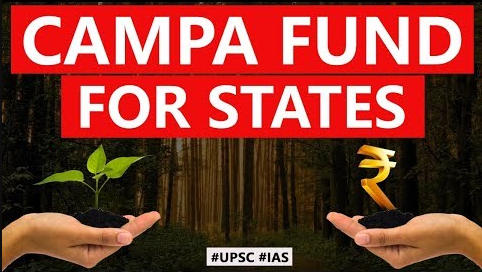Table of Contents
IN NEWS
- In a bid to promote forestry activities and boost afforestation across the nation, the central government on Thursday released a fund of Rs 47,436 crore.
- The top four states that received the highest CAMPA fund are-
- Odisha, Chhattisgarh, Madhya Pradesh, and Jharkhand that received funds of Rs 5,933.98 crore, Rs 5,791.70 crore, Rs 5,196.69 crore and Rs 4,158.02 crore respectively.
- Kerala received the least amount of only Rs 81.59 crore.

- Prakash Javadekar made it very clear that the CAMPA funds cannot be used for payment of salary, travel allowances, medical expenses, etc.

WHAT WILL BE THE EFFECT?
- It will help to achieve the objectives of the NationallyDetermined Contributions of increasing forest and tree cover. (2.5 to 3 billion tonnes of CO2 equivalent)
- The move will help India re-green its forest and non-forest areas which have lost trees due to forest diversions.
- There will also be a balance between Development & Environment.
BACKGROUND
- SC ordered for establishment of Compensatory Afforestation Fund and CAMPA in 2001.
- In 2006, adhoc CAMPA was established.
- But due to absence of enabling rules, much of the funds collected had been left unspent.
COMPENSATORY AFFORESTATION FUND ACT, 2016
- GOI came up with a well-defined Act, known as CAMPA to compensate the loss of forest area and to maintain the sustainability.
- The law establishes the National Compensatory Afforestation Fund under the Public Account of India, and a State Compensatory Afforestation Fund under the Public Account of each state.
ABOUT THE FUND
- The Fund will receive payments for:
- Compensatory afforestation
- Net present value of forest (NPV)
- Other project specific payments
- The National Fund will receive 10% of these funds while the State will receive the 90%.
- Company diverting forest land must provide alternative land to take up compensatory afforestation.
- For afforestation, the company should pay to plant new trees in the alternative land provided to the state.
ABOUT THE RULES
- But the rules for operationalization of funds was notified in August 2018.
- 13 activities are permitted for funding
- Plantation
- Assisted natural regeneration of forests
- Forest fire prevention
- Pest and disease control in forests
- Soil and moisture conservation works
- Improvement of wildlife habitat
- 80% of the compensatory afforestation amount will be utilised by states for above listed works.
- The remaining 20% will be used for to strengthen forest and wildlife protection related infrastructure.
- Also the working plan will be taken up in consultation with the gram sabha or village forest management committee.

CONCLUSION
- The fund should efficiently be used only for afforestation and wildlife conservation activities.
- Restoring the existing forests is more important than creating new ones.
- The concept of outcome budgeting for allocation of funds must be adopted.
Latest Burning Issues | Free PDF






















 WhatsApp
WhatsApp